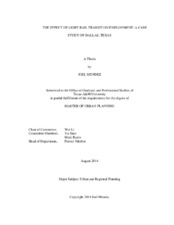| dc.contributor.advisor | Li, Wei | |
| dc.creator | Mendez, Joel | |
| dc.date.accessioned | 2015-02-05T17:25:13Z | |
| dc.date.available | 2016-08-01T05:30:08Z | |
| dc.date.created | 2014-08 | |
| dc.date.issued | 2014-08-05 | |
| dc.date.submitted | August 2014 | |
| dc.identifier.uri | https://hdl.handle.net/1969.1/153376 | |
| dc.description.abstract | The decentralization of residents and jobs from central cities has greatly impacted low income residents as they have remained in the central city while employment opportunities are locating further away. This trend has negatively impacted the employment participation of these residents, worsening their economic situation. Public transit may mitigate this issue by providing direct employment connections to residents and creating employment opportunities through the stimulation of development in the area. This can help attract more jobs into the central city, while potentially increasing the employment opportunities for low income residents.
This study aims to investigate whether proximity to light rail transit influence total employment and various types of employment opportunities by comparing longitudinal employment data within ¼ mile of Dallas Area Rapid Transit (DART) light rail stations to those in the control groups identified through the propensity score matching technique. The propensity score matching method was utilized in an attempt to obtain an adequate control group within the analysis and estimate the influence which proximity to transit has on employment. Additionally, multi-linear regression was integrated into the analysis act as a second level of analysis in the estimation of the influence which proximity to transit has on employment. Although differences in employment were found between areas in close proximity to transit versus comparable areas located elsewhere, it was not found that proximity to transit had a positive or negative influence on employment. The results did not support the stated hypotheses as no significant influence was obtained through this analysis. As seen by these results, the presence of transit does not automatically induce development; certain policies have to be in place in order to encourage it to occur. | en |
| dc.format.mimetype | application/pdf | |
| dc.language.iso | en | |
| dc.subject | Light Rail | en |
| dc.subject | Transit | en |
| dc.subject | Dallas | en |
| dc.subject | Employment | en |
| dc.title | The Effect of Light Rail Transit on Employment: A Case Study of Dallas, Texas | en |
| dc.type | Thesis | en |
| thesis.degree.department | Landscape Architecture and Urban Planning | en |
| thesis.degree.discipline | Urban and Regional Planning | en |
| thesis.degree.grantor | Texas A & M University | en |
| thesis.degree.name | Master of Urban Planning | en |
| thesis.degree.level | Masters | en |
| dc.contributor.committeeMember | Xiao, Yu | |
| dc.contributor.committeeMember | Burris, Mark | |
| dc.type.material | text | en |
| dc.date.updated | 2015-02-05T17:25:13Z | |
| local.embargo.terms | 2016-08-01 | |
| local.etdauthor.orcid | 0000-0002-6331-2461 | |


